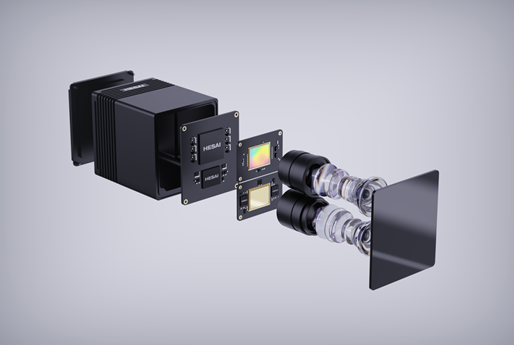Lidar (Laser Detection and Ranging) is an advanced sensing technology that calculates target distance by emitting laser pulses and measuring their return time. It is widely used in fields such as autonomous driving, robotics, and industrial automation. With the development of technology, LiDAR has undergone an evolution from mechanical to semi-solid state and then to solid state. This article will delve into the working principles, characteristics, and applications of solid-state and semi-solid state LiDAR.

一、 Semi solid state laser radar
Semi solid state LiDAR is a transitional form between mechanical and solid-state LiDAR, which achieves scanning through partial mechanical motion. Semi solid state laser radar can be mainly divided into one-dimensional scanning and two-dimensional scanning, and can be further subdivided into MEMS (Micro Electro Mechanical Systems) semi-solid state laser radar, mirror type semi-solid state laser radar, and prism type semi-solid state laser radar according to the different moving parts.
1. MEMS Semi Solid State Lidar
The core of MEMS semi-solid laser radar is a tiny mirror (MEMS micro mirror) that achieves fast and precise movement through electrostatic or thermal actuation, thereby changing the direction of the laser beam. MEMS micro mirrors are integrated on semiconductor substrates, with small size and light weight, enabling high-frequency scanning. This type of LiDAR has high resolution and fast scanning capability, suitable for environmental perception and obstacle detection in dynamic scenes. However, the scanning angle of MEMS micro mirrors is limited, usually within 120 degrees, making it difficult to achieve 360 degree panoramic scanning.
2. Rotating mirror type semi-solid laser radar
The rotating mirror type semi-solid laser radar relies on a rotating mirror to achieve laser scanning. This type of LiDAR typically consists of a motor and a coated mirror, which can be three or four sided and achieve omnidirectional scanning through uniform rotation. Rotating mirror LiDAR has the advantages of simple structure and high reliability, but the scanning frequency and accuracy may be affected by motor performance and reflector material.
3. Prism based semi-solid laser radar
Prism based semi-solid laser radar uses a continuously rotating polygonal prism and a mirror that can swing along the longitudinal axis to change the laser direction. This design only requires one light source to complete the scanning task that can be completed by multiple light sources, but the scanning frequency and power requirements are high, which brings reliability challenges to the scanning device.
二、 Solid state laser radar
Solid state LiDAR is the latest stage in the development of LiDAR technology, with no mechanical moving parts inside, the simplest structure, and the highest integration. Solid state laser radar is mainly divided into two technical routes: phased array (OPA) laser radar and Flash laser radar.
1. Phased Array (OPA) Lidar
Phased array LiDAR changes the scanning direction by controlling the phase of the laser beam. This laser radar consists of multiple laser emission units forming an emission array, and by adjusting the phase difference of each unit, the emission angle of the laser beam can be changed. Phased array LiDAR has the advantages of high precision and high resolution, and the scanning frequency can be very high, making it suitable for scenarios that require fast response and high-precision measurement. However, the technical complexity and cost of phased array LiDAR are relatively high.
2. Flash LiDAR
Flash LiDAR uses a high-density laser source array to emit laser light covering an area in a short period of time, similar to a flashlight, and constructs a three-dimensional image using a high-sensitivity receiver. The emitted light of Flash LiDAR will spread throughout the entire field of view, so the larger the field of view (FoV) it detects, the lower the laser power density, and the corresponding reduction in detection distance and accuracy. In order to improve performance, an addressable scanning Flash LiDAR has been developed, which scans spatial areas by sequentially lighting up the emitters. However, there are still challenges in long-distance detection and large angle coverage.
三、 Application of Solid State and Semi Solid State Lidar
Solid state and semi-solid state LiDAR have broad application prospects in fields such as autonomous driving, robotics, and industrial automation.
1. Autonomous driving
In the field of autonomous driving, solid-state and semi-solid state LiDAR are used for environmental perception, obstacle detection, and 3D map construction. The high resolution and fast scanning capability of semi-solid lidar make it suitable for obstacle detection in dynamic scenes, while the high precision and high reliability of solid lidar make it an ideal choice for the main lidar of autonomous vehicle.
2. Robots
In the field of robotics, solid-state and semi-solid state LiDAR are used for navigation and obstacle avoidance. By providing high-precision 3D environmental information, LiDAR helps robots move autonomously in complex environments, achieving precise positioning and path planning.
3. Industrial automation
In the field of industrial automation, solid-state and semi-solid state LiDAR are used for precision measurement and detection, improving the automation and intelligence level of production lines. The high precision and fast response capability of LiDAR make it an indispensable sensor in industrial automation systems.
四、 Conclusion
Solid state and semi-solid state LiDAR, as the latest achievements in the development of LiDAR technology, have their own unique working principles and advantages. Semi solid state LiDAR achieves high resolution and fast scanning through partial mechanical motion, suitable for environmental perception in dynamic scenes; Solid state LiDAR achieves high precision and reliability by controlling the phase or emission array of the laser beam, making it suitable for scenarios that require fast response and high-precision measurement. With the continuous advancement of technology and the reduction of costs, solid-state and semi-solid state LiDAR will play an increasingly important role in fields such as autonomous driving, robotics, and industrial automation.
Source: Sensor Expert Network



